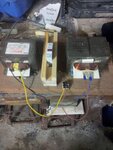boylesg
Advanced Member level 4

- Joined
- Jul 15, 2012
- Messages
- 1,023
- Helped
- 5
- Reputation
- 10
- Reaction score
- 6
- Trophy points
- 1,318
- Location
- Epping, Victoria, Australia
- Activity points
- 11,697
Thanks to those who were helping me out with this. But this is what I have so far. This was just a quick test to make sure it didn't blow any fuses and it didn't.
I have wired those two primaries in series with that safety switch like device (8Amps) between them. I will have to secure all those loose wires and devise some sort of cover for it when it is in use.
The coloured insulated wires were from the power cords of the microwave ovens I extracted the transformers from so I should be OK. I plan to draw perhaps up to 5Amps at 84V AC from the secondaries and, judging by what others have said about this, that seems about right re power. I will stick some fuses on the secondary side as well to make sure that any slip ups don't result in a flaming transformer.

I have wired those two primaries in series with that safety switch like device (8Amps) between them. I will have to secure all those loose wires and devise some sort of cover for it when it is in use.
The coloured insulated wires were from the power cords of the microwave ovens I extracted the transformers from so I should be OK. I plan to draw perhaps up to 5Amps at 84V AC from the secondaries and, judging by what others have said about this, that seems about right re power. I will stick some fuses on the secondary side as well to make sure that any slip ups don't result in a flaming transformer.


